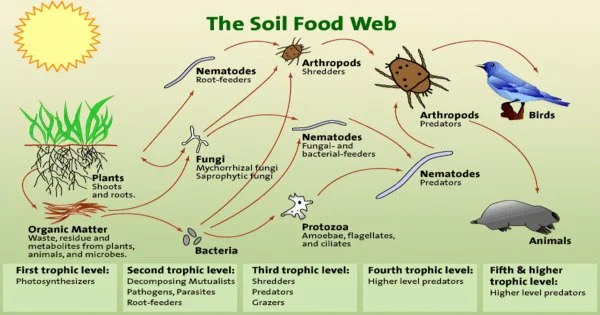The soil food web is a complex and linked structure of organisms that live in the soil and contribute to nutrient cycling and soil health. It is a colony of organisms that spend all or part of their lives in soil. It includes species such as bacteria, fungus, protozoa, nematodes, mites, insects, and others. It explains the interactions of a complex biological system in the soil with the environment, plants, and animals. These species interact dynamically and symbiotically with one another, establishing a complex web of interactions.
The flow of energy between species in an environment is described by food webs. A food web is more complex than a food chain since it depicts all of the potential energy paths through an ecosystem. The sun accounts for a large portion of the transferred energy. By photosynthesis, plants use the sun’s energy to convert inorganic components into energy-rich, organic compounds, converting carbon dioxide and minerals into plant material. Plant blooms pour energy-rich nectar above ground, while plant roots discharge acids, sugars, and ectoenzymes into the rhizosphere, regulating pH and nourishing the underground food web.
Key components of the soil food web include:
- Bacteria and Archaea: These microorganisms play a crucial role in breaking down organic matter into simpler compounds, making nutrients available to plants.
- Fungi: Soil fungi, including mycorrhizal fungi, form symbiotic relationships with plants, aiding in nutrient uptake and promoting plant growth.
- Protozoa: These single-celled organisms feed on bacteria and other microorganisms, helping regulate their populations and contributing to nutrient cycling.
- Nematodes: Some nematodes are beneficial as they feed on bacteria, fungi, and other nematodes. Others may be harmful to plants.
- Arthropods: Soil-dwelling arthropods, such as mites and springtails, contribute to the decomposition of organic matter and the regulation of other soil organisms.
- Earthworms: Earthworms are important for soil structure improvement and nutrient cycling. They ingest organic matter, breaking it down and excreting nutrient-rich castings.
- Microarthropods: These tiny arthropods, including mites and springtails, contribute to nutrient cycling and decomposition.
Soil food web interactions are critical for maintaining soil fertility, structure, and overall health. Healthy soil promotes plant development, improves water retention, and helps to ecosystem resilience.
Avoiding the overuse of synthetic fertilizers and pesticides, encouraging organic matter addition, and keeping a diverse plant cover can all assist to support and improve the diversity and functioning of the soil food web. Soil food web conservation is critical for sustainable agriculture and ecosystem health.
















